50 Years of Text Games: Ultimate Collector's Edition
For the "50 Years of Text Games" Ultimate Collector's Edition, a premium pledge level for backers of the crowdfunding campaign, a box of special items was produced. Early computer games often came with "feelies," bonus goodies from enchanted rocks to replica coins to secret decoder wheels, to draw players into their world (and sometimes, for copy protection). The Ultimate Collector's Edition included feelies that lent a tactile connection to an earlier age of digital gaming history. This page documents the contents of the box.
The Ultimate Collector's Edition is sold out.
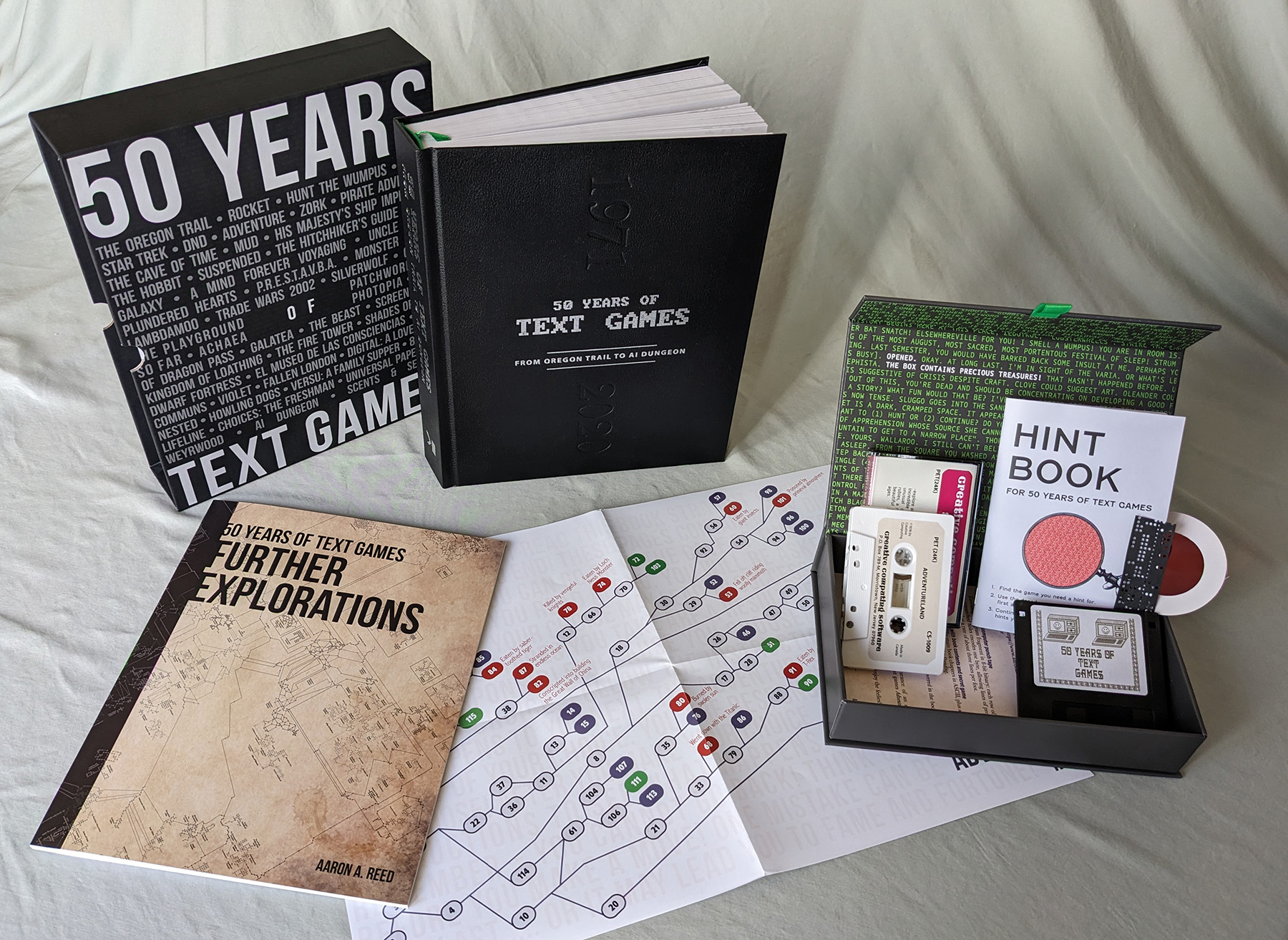
Poster
One of three posters is included in the Ultimate Collector's Edition.
- The A Mind Forever Voyaging poster features an original map of the game's setting of Rockvil, South Dakota, showing the full navigable grid of streets and buildings, subway system, and other points of interest (some interior rooms are omitted). The map shows the state of the world in 2041, the first simulated year (it changes in subsequent decades as the city begins to decline).
- The Choose Your Own Adventure poster features a map of "The Cave Of Time," the first book in the series: numbers correspond to pages in the book. Some pages with no choices are omitted. Colored-in nodes represent endings: red are bad, green are good, and others are more ambiguous. Death endings are labeled.
- The Dwarf Fortress poster features a world map generated by the game's first public release in 2006, rendered in ASCII characters. (Only a portion of this would be visible to in-game players at any one time, but the game outputs the full map to disk as part of generation.) Even at this early point, the complexity of the generation code can clearly be seen, particularly in the paths of rivers finding their way to lower elevations and seas.
Paper Tape
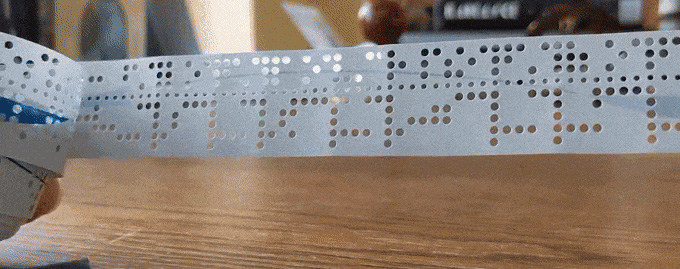
In the 1960s and 70s, computer punch cards gave way to more flexible punch tape, which could be of variable length and always stayed in the right order. Punch tape would encode programs in 8-bit binary at the rate of about three lines of code per foot, with each row encoding a single character through a pattern of eight punched or unpunched holes. (A smaller set of sprocket holes was also often present, as in the image above, used to help mechanically advance the tape). Some of the earliest titles in the 50 Years of Text Games book would have been stored and distributed on rolls of punch tape: Hunt the Wumpus, for instance, could be ordered on paper tape from Creative Computing magazine.
The item in your box is a genuine piece of vintage paper punch tape from the 1970s, although I unfortunately don't have any information about what programs were encoded on these rolls.
Replica Adventure Game Cassette
The earliest software for home computers was sold on cassette tapes, an existing analog storage medium that could be plugged into microcomputers before dedicated disk drives became commonplace and affordable. In 1978, Scott and Alexis Adams began selling Adventureland and Pirate Adventure out of the backs of magazines. This item is a replica prop of one of these early releases, predating the official launch of their company Adventure International and published instead by Creative Computing, then the leading magazine for amateur home computer enthusiasts. This was one of the earliest commercial releases of a game for home computers.

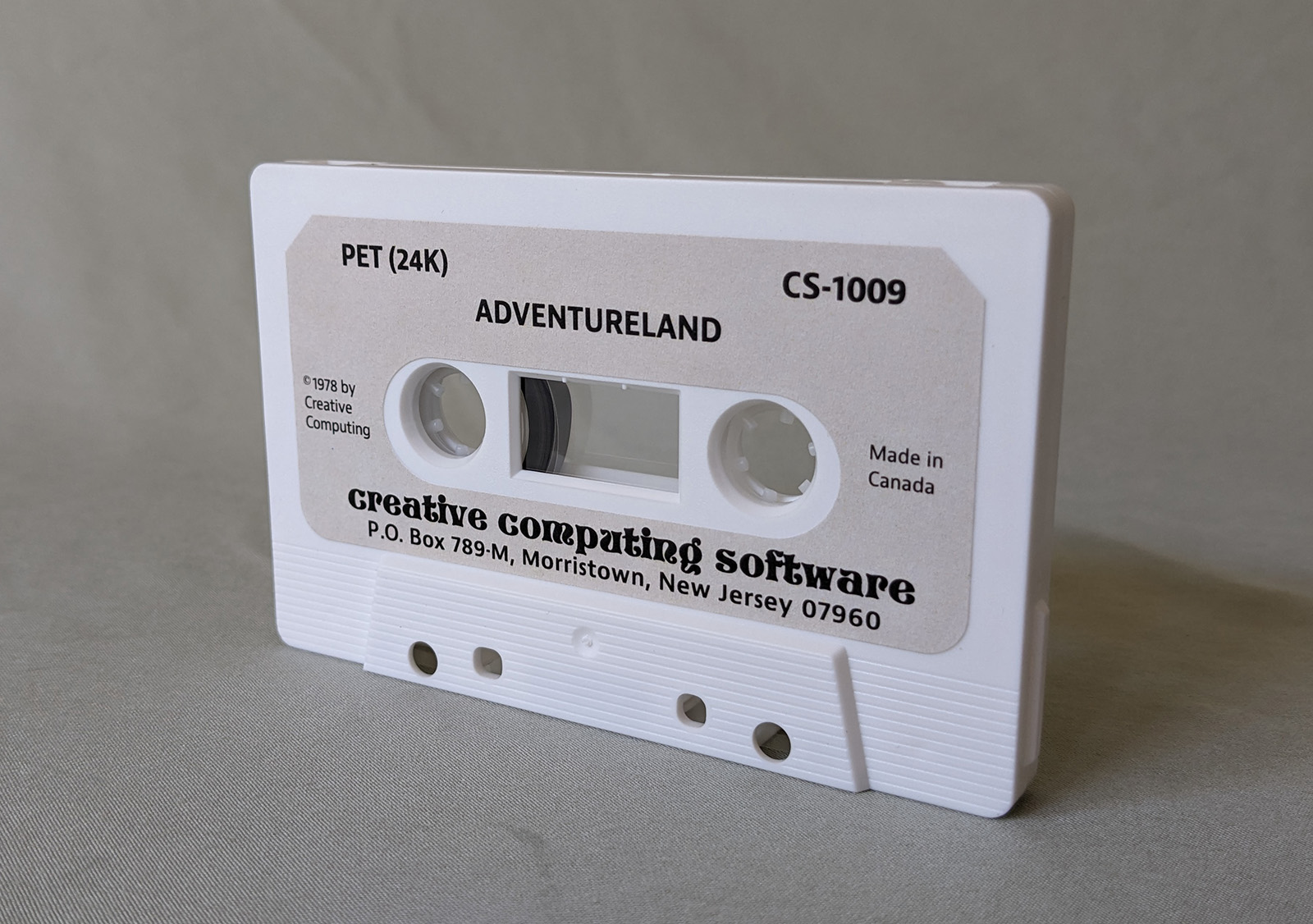
Images of original item for comparison
The prop recreates the original box art, cassette, and instructions. It was created with the blessing of Scott Adams (and indirectly, David H. Ahl of Creative Computing, who as a result of inquiries about this project released all of the company's assets into the public domain). The replica tape does not contain the original games, but it does have a short Commodore PET BASIC program, which adventurous hackers with the right equipment should be able to load and execute to uncover a secret message. If played in a regular tape player, the encoded program will sound similar to the modem noises heard by anyone familiar with the days of dial-up internet.
Differences Between the Replica and the Original Release
The reproduction tape contains several differences from the original, some deliberate to avoid it being mistaken for the real thing by collectors. Here is a list of the major differences:
- The replica tape has the text "Made in Canada" on the cassette label and in the inset booklet. In the original release, these read (and were) "Made in USA."
- The replica tape is labeled "Adventureland" on one side and "Pirate Adventure" on the other. The original release shows "Adventureland" on both sides: it's likely that both games were encoded on each side of the tape, a common practice at the time for distributing games. This was a deliberate change to help commemorate the contributions of Alexis Adams to Adventure International's history (see the book's chapter on Pirate Adventure for the full story).
- The replica box contains a JP5 insert with both the cover and instructions printed as a single piece. In the original release, the instructions were a separate insert printed on receipt paper.
- The replica tape contains a short original BASIC program, encoded in 61 seconds of audio. The original contained a longer audio stream encoding the actual Adventure International games.
- The replica uses a slightly different tape and case style than the original (based on the closest styles that could be sourced during manufacture).
Floppy disk
Floppy drives were ubiquitous through the 80s, slowly giving way to CD-ROMs and downloads in the 90s. A 3.5" floppy held 1.44 MB of data, which seemed like a lot when they first came out.
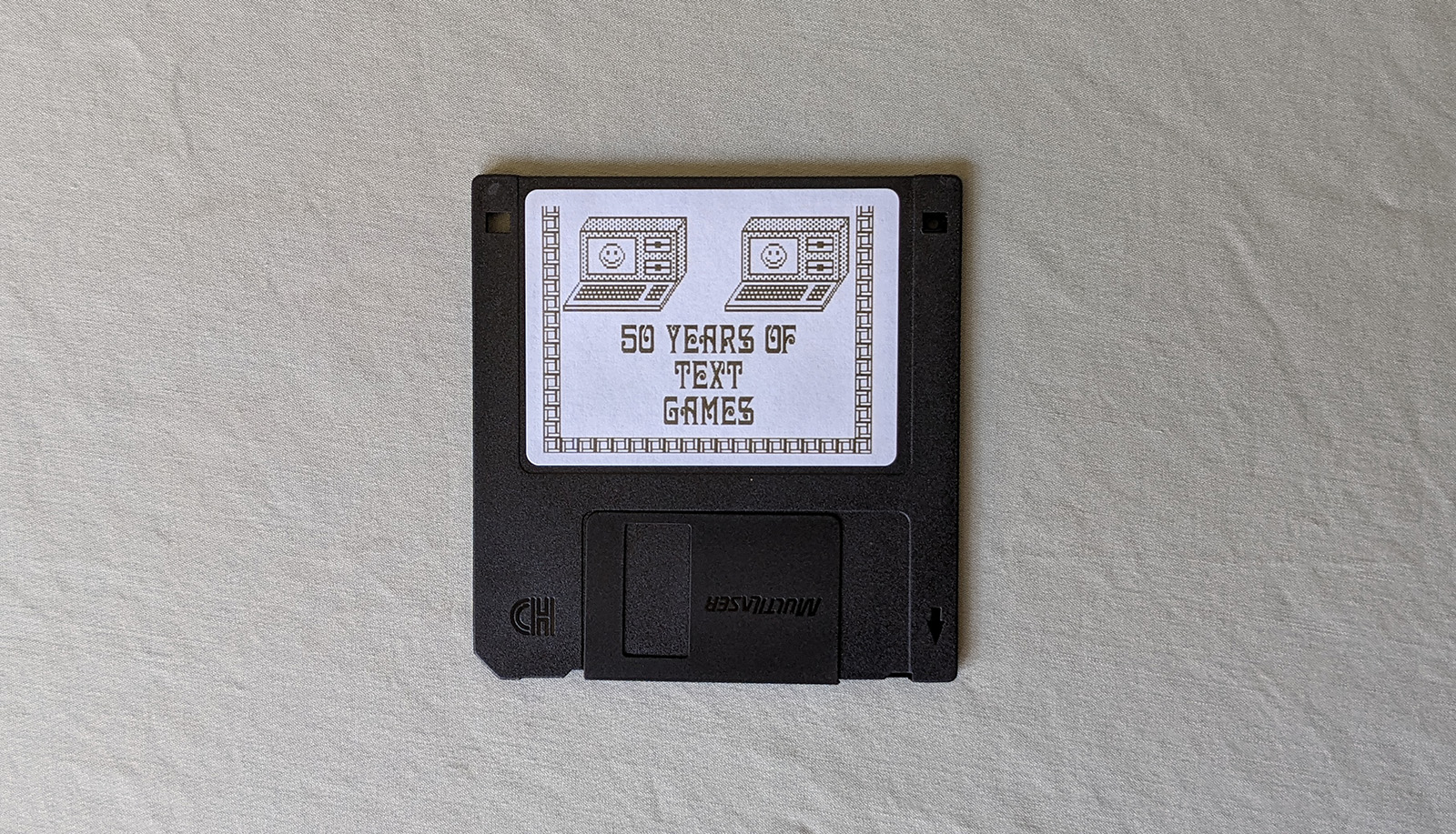
This floppy disk has a label designed in vintage program The Print Shop. The disk contains the full text of each of the main game chapters from the "50 Years of Text Games" book. (Note that for space reasons certain material such as the introduction, decade overviews, and game listings are omitted; although this content is part of the plain text version of the "50 Years" digital download.)
Also on the disk you'll find a bonus text game created specifically for this feelie, "You Are Standing," written by author Aaron A. Reed using Inform 6 (by Graham Nelson) and the PunyInform library (by Johan Berntsson and Fredrik Ramsberg). The game explores different styles of text game over the years and tells a story about legacies and love. See the readme file on the disk for info on running the game. [Update circa 2024: You Are Standing has now been released to the general public and can be played online.
UCE backers can download a zip file of the floppy disk's contents (see instructions at the top of this page).
Hint book and decoder wand
Hint books were common in the days when most games had puzzles. Early game companies figured out this could be a valuable secondary revenue stream: they opened 900 number phone trees and sold hint books of varying designs to desperate fans. At one point, both Infocom's and Adventure International's hint books were outselling their games (probably due to rampant software piracy).
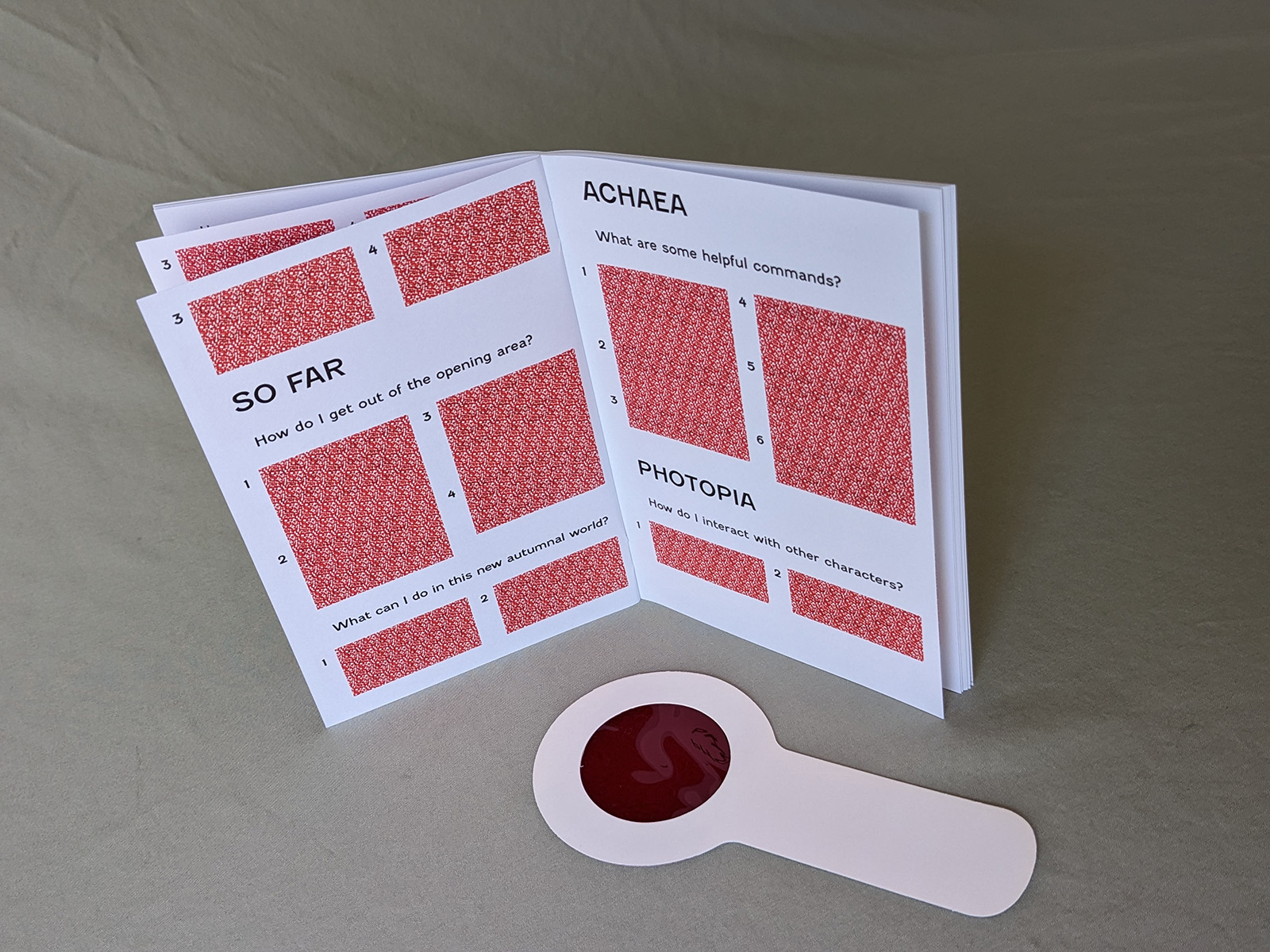

To keep from accidentally seeing hints you didn’t need, and also to prevent hint books from being easily photocopied, companies used various forms of obfuscation in their books, from invisible ink to numeric cyphers to cardboard decoder wheels. The Ultimate Collector's Edition hint book honors this tradition by obscuring hint answers with a red pattern. Hold the decoder wand over an answer to reveal it (you may need strong direct lighting for the text to be legible).
The hint book contains at least one hint for each of the fifty titles convered in the book— yes, even for games which are no longer playable or don't have any puzzles! Don't expect comprehensive hints for each game— this is a sampler, not an omnibus!— but the hints aim to be helpful to new players just encountering each game for the first time.
The contents of the hint book are available to UCE backers as a standalone text file, both in plain and rot13 encoded versions (see instructions at the top of this page).